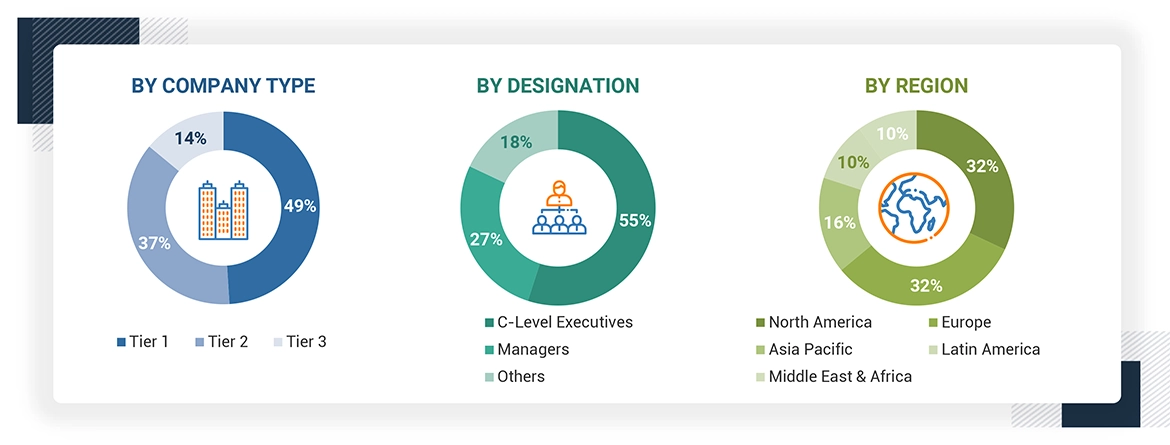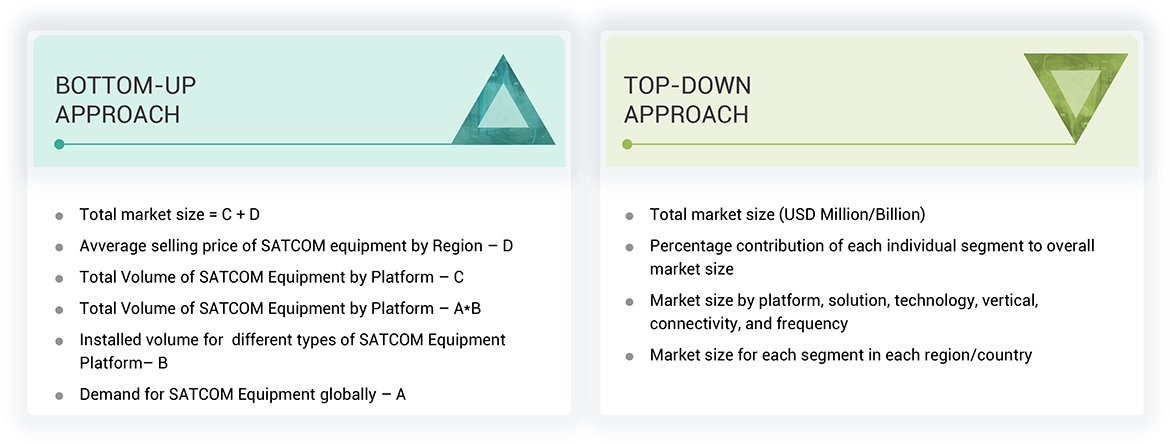This research study involved the extensive use of secondary sources, directories, and databases, such as D&B Hoovers, Bloomberg Businessweek, and Factiva, to identify and collect information relevant to the SATCOM Equipment market. Primary sources included industry experts from the core and related industries, as well as preferred suppliers, manufacturers, solution providers, technology developers, alliances, and organizations related to all the segments of this industry’s value chain. All primary sources were interviewed to obtain and verify critical qualitative and quantitative information and assess prospects for market growth during the forecast period.
Secondary Research
The share of companies in the SATCOM Equipment market was determined using secondary data made available through paid and unpaid sources and analyzing product portfolios of major companies in the SATCOM market. These companies were rated based on the performance and quality of their products. These data points were further validated by primary sources.
Secondary sources referred to for this research study on the SATCOM Equipment market included financial statements of companies offering and developing SATCOM Equipment and information from various trade, business, and professional associations, among others. Secondary data was collected and analyzed to determine the total size of the green methanol ships market, which primary respondents further validated.
Primary Research
Extensive primary research was conducted after obtaining information about the current scenario of the SATCOM Equipment market through secondary research. Several primary interviews were conducted with market experts from the demand and supply sides across North America, Europe, Asia Pacific, the Middle East, and Latin America. This primary data was collected through questionnaires, emails, and telephonic interviews. In the primary research process, varied primary sources from the supply and demand sides were interviewed to get qualitative and quantitative information on the market. Primary sources from the supply side include different industry experts like vice presidents, directors, regional managers, technology providers, product development teams, distributors, and end users.
Primary research has been done through interviews to get information that includes market statistics, revenue collection data from the products and services, and market breakups, size estimations, market forecasting, and data triangulation. Through primary research, the trends of technology, application, platform, and region were also understood. Demand-side stakeholders, such as CXOs, production managers, engineers, and installation teams of end users of SATCOM Equipment, were interviewed to understand the buyer’s perspective on the suppliers, products, service providers, and their current usage and future outlook of their business, which could affect the SATCOM Equipment market.

Note: C-level Executives include the CEO, COO, and CTO, among others.
*Others include Sales Managers, Marketing Managers, and Product Managers.
The tiers of the companies have been defined based on their total revenue as of 2022.
Tier 1 = > USD 1 billion, Tier 2 = USD 100 million to USD 1 billion, and Tier 3 = < USD 100 million
To know about the assumptions considered for the study, download the pdf brochure
Market Size Estimation
Both top-down and bottom-up approaches were used to estimate and validate the size of the SATCOM Equipment market. The research methodology used to estimate the market size includes the following details:
-
Key players were identified through secondary research, and their market ranking was determined through primary and secondary research. This included a study of annual and financial reports of the top market players and extensive interviews of leaders, including CEOs, directors, and marketing executives.
-
All percentage shares, splits, and breakdowns were determined using secondary sources and verified through primary sources. All possible parameters that affect the markets covered in this research study were accounted for, viewed in extensive detail, verified through primary research, and analyzed to obtain the final quantitative and qualitative data. This data was consolidated, enhanced with detailed inputs, analyzed by MarketsandMarkets, and presented in this report.

Data Triangulation
After arriving at the overall size of the SATCOM Equipment market from the market size estimation process explained above, the total market was split into several segments and subsegments. To complete the overall market engineering process and arrive at the exact statistics for various market segments and sub-segments, the data triangulation and market breakdown procedures explained below were implemented, wherever applicable. The data was triangulated by studying various factors and trends from both the demand and supply sides. The market size was also validated using both the top-down and bottom-up approaches.
Market Definition
SATCOM equipment refers to devices used in satellite communication systems. These devices are designed to facilitate the transmission and reception of signals between satellite networks and ground-based stations or user terminals. They are pivotal in establishing reliable communication links, enabling applications such as broadband internet access, voice communication, data transfer, video broadcasting, remote sensing, and IoT connectivity. SATCOM equipment can handle multiple frequencies, bandwidths, and transmission protocols, making it instrumental in connecting remote areas, maritime and aviation communication, disaster response, and other communications needs.
Stakeholders
-
Military Antenna Manufacturers
-
System Integrators
-
Original Equipment Manufacturers
-
Military Service Providers
-
Research Organizations
-
Investors and Venture Capitalists
-
Ministries of Defense
-
R&D Companies
Report Objectives
-
To define, describe, segment, and forecast the size of the green methanol ships market based on platform, technology, solution, vertical, frequency, connectivity, and region.
-
To forecast the size of various segments of the market with respect to five major regions, namely North America, Europe, Asia Pacific, Middle East & Africa, and Latin America, along with major countries in each of these regions.
-
To identify and analyze key drivers, restraints, opportunities, and challenges influencing the growth of the market across the globe.
-
To identify industry trends, market trends, and technology trends currently prevailing in the market.
-
To provide an overview of the regulatory landscape with respect to SATCOM Equipment regulations across regions
-
To analyze micromarkets1 with respect to individual growth trends, prospects, and their contribution to the overall market
-
To analyze opportunities in the market for stakeholders by identifying key market trends
-
To profile key market players and comprehensively analyze their market share and core competencies2.
-
To analyze the degree of competition in the market by identifying key growth strategies, such as, agreements, acquisitions, contracts, and partnerships, adopted by leading market players.
-
To identify detailed financial positions, key products, and unique selling points of leading companies in the market
-
To provide a detailed competitive landscape of the market, along with market ranking analysis, market share analysis, and revenue analysis of key players



Growth opportunities and latent adjacency in Satellite Communication (SATCOM) Equipment Market